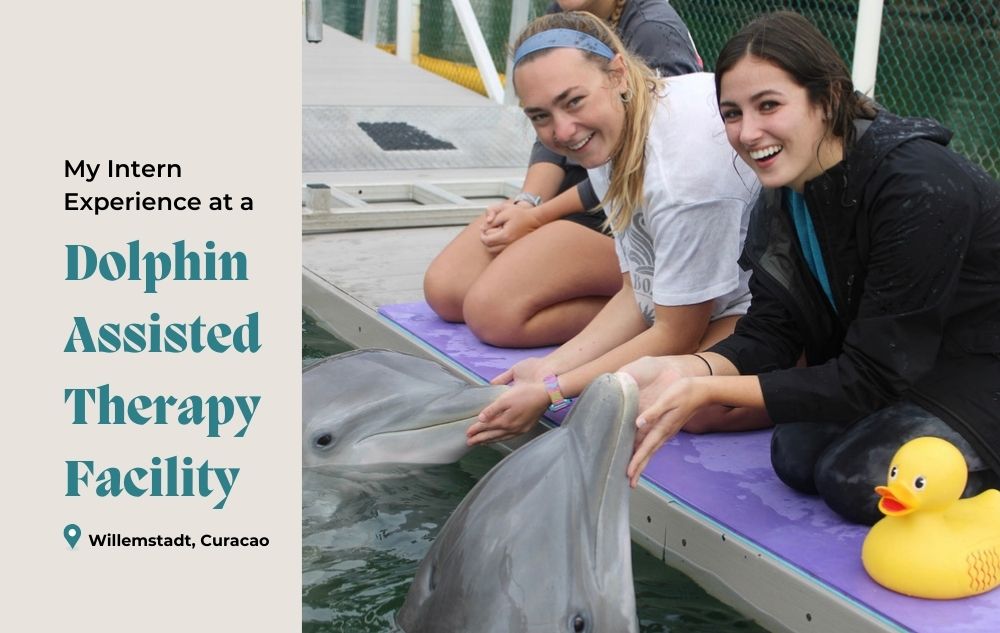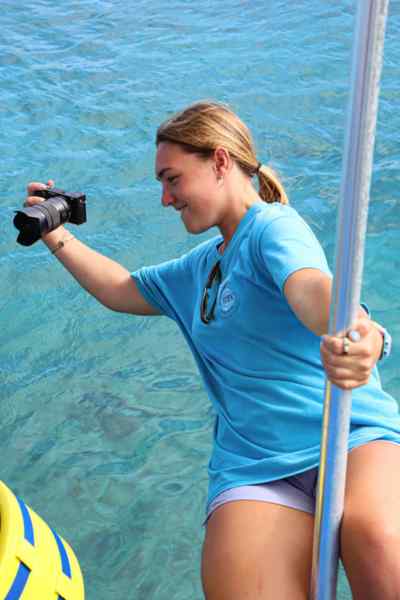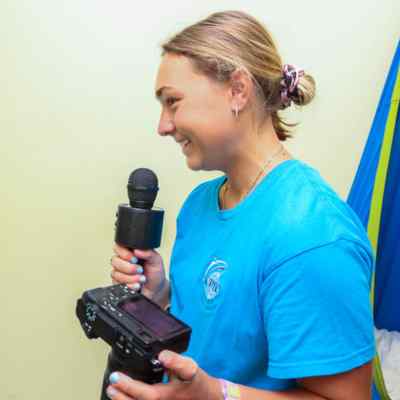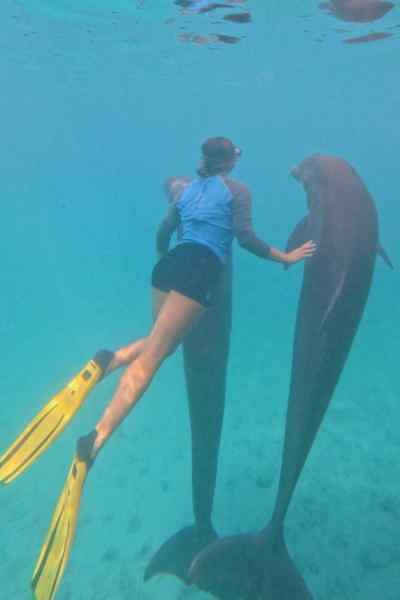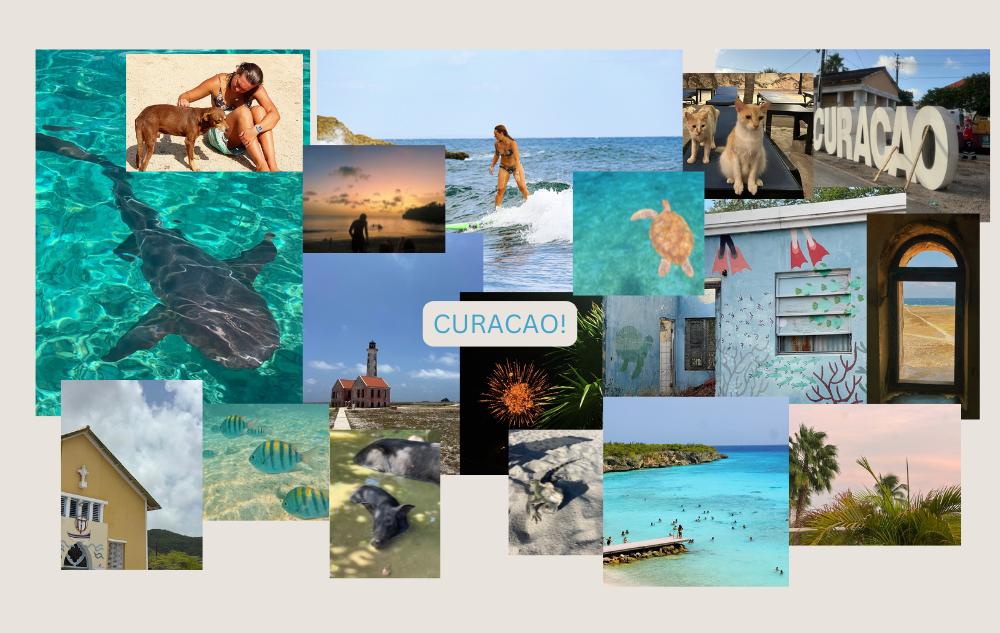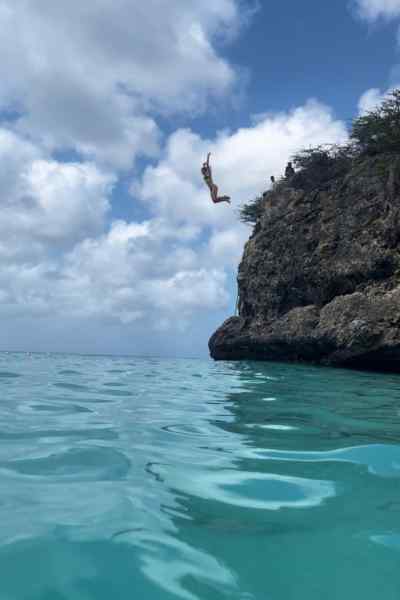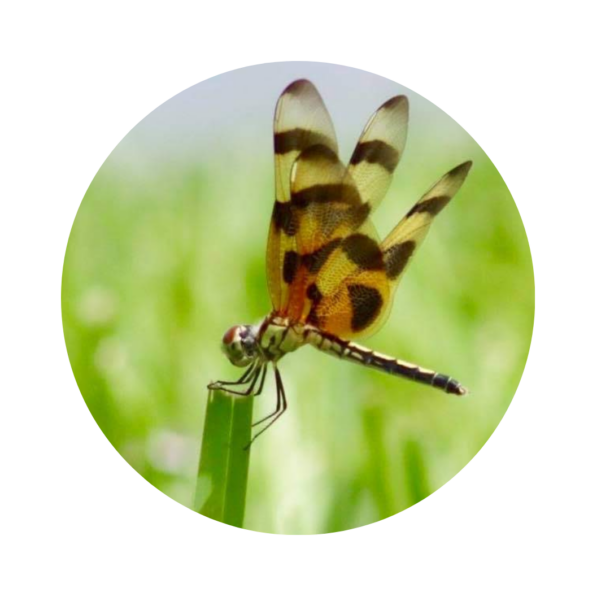In our recent blog, Dolphins: Marine Bellwethers and Humanitarian Helpers, we shared some fascinating facts about these incredible creatures. OPL internist, Anna O’Reilly, adds to the human-dolphin connection by writing about her recent dolphin assisted therapy intern experience at the Curacao Dolphin Therapy and Research Center in Willemstad, Curacao.
I’ve always been fascinated by the ocean and marine life, which was one of the reasons I chose to major in Environmental Studies and Animal Studies at Eckerd College. In early 2024, I had the opportunity to visit two Dolphin Assisted Therapy (DAT) facilities as a student observer: Island Dolphin Care (IDC) in Key Largo, FL and Curacao Dolphin Therapy and Research Center (CDTC) in Willemstad, Curacao. I enjoyed my time immensely at CDTC, and was thrilled to be invited back for a 7-week internship in July 2024. This time, I joined the CDTC as a photographer, videographer, and media editor.
What is Dolphin Assisted Therapy (DAT)?
Dolphin Assisted Therapy (DAT) is a type of Animal Assisted Intervention (AAI) in which individuals spend time among dolphins to improve physical, verbal, and social skills. The most common clients for this type of therapy are children with severe mental, behavioral, and physical conditions. However, positive results have been seen among adult clients as well, including war veterans suffering with severe PTSD. As the practice evolves, so does the list of conditions and clients that DAT can treat.
While DAT is controversial, it can have meaningful benefits for people and captive dolphins alike. Our natural human desire to be connected to nature (biophilia) and our history-long infatuation with charismatic megafauna (big, “relatable” mammals – like dolphins) create a natural bond between client and dolphin. This bond helps facilitate the therapeutic process.
The Curacao Dolphin Therapy and Research Center and Its Patients
The Curacao Dolphin Therapy and Research Center (CDTR) is one of only eleven DAT facilities across the globe. They seek to help individuals with neurodivergent and genetic disorders, such as ADHD, Autism Spectrum Disorder, Cerebral Palsy, and Down Syndrome. CDTR also treat patients who suffer psychological disorders, such as anxiety, bipolar disorder, depression, and Dissociative Identity Disorder (DID). DAT also benefits individuals who have experienced trauma, amputation, chronic pain and illness, cancer, cerebral hypoxia, and stroke.
Research on the effectiveness of DAT has been debated, but the therapy seems to have significant positive impacts, especially for those with Autism Spectrum Disorder. Multiple DAT locations have reported success stories for treating PTSD, with patients sharing how the therapy experience changed their lives. While some studies disprove the positive effects of DAT, much of this negative research stems from the location and conduct of the studies. DAT is difficult to practice, but those who are able to do so successfully have improved the quality of life of many. Due to scientific disputes in research, DAT is not considered a certified therapy.
My Role at CDTC
My time working at the CDTC was amazing! I spent most of my time filming therapy, editing patient videos, and creating highlight reels for CDTC’s Instagram page. Additionally, I shadowed therapists and dolphin trainers, often getting involved with individual therapy sessions and various workshops. And yes, interacting with the dolphins!
I saw firsthand how the therapeutic experience unfolded between patients and the dolphins. Each experience was vastly different. For some patients, their faces would light up as soon as they entered the water. For others, entering the water was a relaxing, calming experience. Some patients gained confidence and found their voice among the dolphins.
A truly rewarding experience!
Being able to capture patients’ diverse responses was fascinating and rewarding, and changed the way I thought about DAT. I witnessed a therapist’s joy when a nonverbal child made strides towards communicating for the first time. I saw the palpable relief on a parent’s face as they watched their child smile – a small gift that is too easily taken for granted. It was truly a gift to hear laughter and joy from children who struggle to communicate due to their physical or mental limitations.
The picture to the left is of me singing for a patient. I was asked to film her therapy but was passed a microphone instead. My (rather horrible) attempt at singing for her made her crack a smile for the first time all week. I got to make her laugh and smile, and we all experienced a moment of joy together. That was really special.
The Dolphins at CDTC
There are currently five dolphins at the CDTC: Bonnie, Ritina, Nubia, Chubelita, and Kanoa. Just like us, all of the dolphins have their own unique quirks and personalities. Once you spend enough time among the dolphins, they become easily identifiable by both their physical and personality characteristics. When scheduling a new patient for therapy, trainers consider the dolphins’ individual attributes to determine which dolphin would best meet the patient’s needs.
For instance, Kanoa is fast and strong, so he is often paired with more able-bodied patients who may have more communicative and personality goals. A fragile, sensitive, or meek patient would be a better fit for a gentler dolphin like Bonnie. The first day of therapy is typically spent moving dolphins around to test how they each interact with the patient. Once a pairing has been established, the patient sees the same dolphin for two weeks. This allows the pair to form a deeper bond and strengthen the therapeutic experience.
Dolphins at CDTC can always opt-in or out for treatments.
Dolphins, like any animal, can be unpredictable. This can make therapy and filming difficult at times (but it was great practice!). The CDTC allows their dolphins to opt in or out of therapy. They are given the choice to participate or not, and they are not punished for choosing not to participate. Luckily, the dolphins are excited by therapy and almost always want to join. In fact, they can sometimes get jealous and try to displace another dolphin if they are not selected for a session. To avoid disrupting sessions, any dolphin not scheduled to see a patient is given a trainer to swim with so they have company while the “at work” dolphins complete their session.
In some cases, two dolphins might be paired together to assist a patient. Some dolphins work better together, which is something that the trainers pay specific attention to. Dolphins have a complex pod structure and there are hierarchies in their relationships: there is a clear alpha and subsequent order in the pod.
Ritina, my favorite dolphin at CDTC (and arguably, in the world).
Ritina stole my heart during my 7 weeks at CDTC. She is originally from the Sea Aquarium that borders the CDTC. One day she swam into the CDTC, and then decided to stay! She has a very bubbly energy and gets super excited all the time. After doing a hard trick or new behavior she gets so proud of herself and squeals super loud! It is so fun to watch and is my favorite part about her.
I had the opportunity to swim with her twice. She is so FAST! One afternoon, Ritina and Bonnie gave me a deep-dive tour of the lagoon. Holding onto both of them kept Ritina at a slower, much more manageable, pace (Bonnie is better at slowing down). I got to experience first hand how two dolphins can work together to create the perfect therapy environment. And getting to swim and dive with two dolphins was an awesome experience!
Adventures Outside the CDTC
Although my primary focus in Curacao was my internship, I also had plenty of time to explore the island. I lived on a decommissioned warship with 7 other CDTC interns. When we weren’t at the CDTC, we were trying to experience as much of the island as we could.
Curacao is just less than 50 miles from the coast of Venezuela – but you would never know with the cloud cover! I only saw the Venezuelan mountains once when the skies were extremely clear. Because of its location near the mountains, Curacao is protected from hurricanes and big storms. It also has a constant stream of wind, so although it gets hot, the breeze keeps it from getting too unbearable. During the summer, the mountains are only open for hiking before sunrise – otherwise it is just too hot! It truly is a little island in the sun.
There is a booming world of biodiversity underwater. You can swim off of any beach on the island and see a bounty of fish. I was spoiled by the wildlife, getting to swim with so many sea turtles, sting rays, tropical fish, and crabs. I swam daily and saw something new almost every time. Some of the coolest things I saw were manta ray, queen conch, stone fish, and lemon and nurse sharks.
From Cliffs to Wildlife, Curacao Has It All
The north side of Curacao has a rocky coast full of cliffs – and is the only place you can find real waves! There are not many beaches and only a few spots where you can access the water. These few access points are where people go surfing. Due to the structure of the coast, you have to carefully paddle around the reefs and out to where it is deep enough to surf without disturbing the reefs. Although the waves were small, getting to see turtles and lion fish made it a top surf spot for me!
Where the cliffs and beaches meet, there are amazing spots where locals and visitors alike can be seen jumping from various cliff faces into the calm water below. You definitely need to know the spot before you jump (never jump into rough water on the north side!). But once you find a good spot, you can cliff jump safely (super fun!).
The cliffs in Curacao are unique where the North and South coasts converge. The sights are so varied and it’s fascinating to see how the Earth works to create these differences. And also, I just love cliff jumping!
A Truly Memorable Experience
While Dolphin Assisted Therapy (DAT) is still controversial, I believe full-heartedly that it works wonders. I am a firm believer in science and the validity of scientific methods, so it is hard for me to be convinced by something that lacks that validation. But the experience I had at CDTC convinced me that their program is successful. The reactions and smiles I captured during therapy sessions are proof that dolphin assisted therapy can enrich both dolphin and human lives.
Although scientific credit would help make dolphin assisted therapy more accessible, I do not think it is needed to prove that it works. I met the adults whose stories founded the basis of DAT, and witnessed firsthand how their lives were positively changed from this therapy. For so many children, I saw their mobility change and their confidence grow. Some patients developed new communication methods or improved how they expressed themselves.
In the therapy world, breakthroughs can be difficult, and even the smallest changes need to be celebrated. These positive, small victories are seen every day at the CDTC.
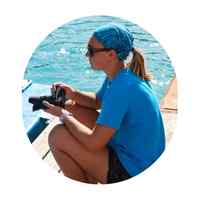
Written by Anna O'Reilly
One Planet Life Intern
“I grew up spending my summers in Ocean City, NJ and have always been fascinated by marine life. I’m currently pursuing a double major in Environmental Studies and Animal Studies and a minor in Sustainability at Eckerd College. Interning with One Planet Life has been an amazing experience, and I’m proud to support their mission to help others live more sustainably and protect our planet.”

